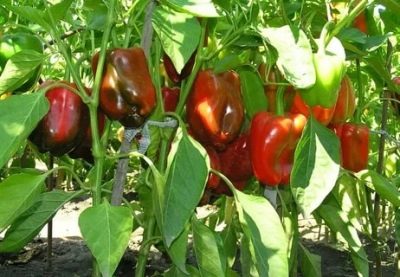
- Name synonyms: Antei
- Year of approval: 2018
- Bush height, cm: 60-70
- Growth type: medium-sized
- Fruit shape: cuboid
- Fruit weight, g: 215-220
- Fruit color: in technical ripeness dark green, biological - red
- Ripening terms: early
- Yield: high
- Average yield: 7.9-8.4 kg / m2
Pepper Antey is a representative of sweet large-fruited hybrid varieties; quite a few gardeners like it. Thanks to its excellent immunity, the culture develops well and bears fruit in temperate latitudes and in the southern regions; you can see it in Siberia and the Far East.
Description of the variety
Antaeus is a relatively new hybrid of sweet pepper that is not yet very popular on the market. The culture was bred in the MICHAEL FORSHTAT company by Israeli breeders for a long time. But it is included in the State Register only in 2018. Recommended for cultivation inside film greenhouses and the same shelters in private farms.
Characteristics of the appearance of plants and fruits
Anthea plants are medium-sized semi-stemmed spreading bushes. The stems are 60-70 centimeters long, the root system is powerful.
The foliage is medium in size, green in color. The peppers have a semi-plump arrangement. The fruits are in the form of a cube, the skin is glossy. At the stage of technical ripeness, it is colored dark green, at biological maturity it is red. Pepper wall thickness - 6-7 mm. The weight of the peppers is 215-220 grams, each with 3-4 chambers.
Purpose and taste
The fruits are tasty, quite fleshy, they are distinguished by a high content of many useful substances, such as vitamin C, it is 92-129 mg in 100 grams of fruits. Sugars in peppers are 6.7%, dry matter is contained in an amount of 7-8.5%. Peppers are mainly eaten fresh, they are used for cooking many dishes, and canned.
Ripening terms
Antaeus is an early ripening pepper. Manages to ripen completely in 98-115 days.
Yield
A yielding Israeli hybrid variety is on average capable of producing from 7.9 to 8.4 kilograms per square meter. meters.
Growing regions
The Antey pepper hybrid is successfully cultivated in different regions not only in our country. This is the middle strip, and the Kuban, and the Crimea, and Ukraine, and Moldova. The culture does well during periods of heat.

To get a large and tasty harvest of pepper, you need to take care of the seedlings in advance. When growing pepper seedlings, you need to correctly determine the sowing time, pre-sowing seed treatment, prepare the necessary container and soil.
Growing and care
Antaeus F1 is most often cultivated by seedlings. Planting of seed is carried out in the 2-3 decade of March. For this, it is better to take peat pots, but containers are also possible. If the seed is purchased from a trusted company, the seeds do not need to be processed, all the seed preparation is undertaken by the seed manufacturer.
Optimally, the substrate for planting Antey pepper should consist of turf (2 hours), compost (2 hours), peat (2 hours), sand (1 hour).
The resulting soil must be disinfected:
- potassium permanganate solution;
- By calcining for 30 minutes, for example in an oven;
- using boiling water.
After sowing the seeds in the soil mixture, the container should be covered with either foil or glass. For 10 days, the temperature regime should be +25 degrees Celsius.
After the sprouts appear, containers or pots are placed in a cooler place, namely + 17 ... 18 degrees. Irrigate plantings with a sprayer.
The grown seedlings are transferred to a permanent place after warming in the street to + 15 ... 20. When planting between holes, a distance of 50-60 centimeters should be observed.
The agrotechnics of growing the Antey hybrid is quite simple. It consists of regular irrigation, top dressing. At the first stage, nitrogen fertilization is needed for the culture (nitroammofoska, as well as mullein or droppings). When the culture begins to bloom, many gardeners use ready-made mineral complexes. At the beginning of tying peppers, phosphorus-potassium substances will be important to the plant.

To harvest a tasty and rich harvest of pepper, you need to comply with all the conditions of agricultural technology, and proper care begins with planting plants. Before planting pepper in open ground, it should be prepared. It is also important to take care of the seedlings and planting space in advance.




For good growth of pepper bushes and active fruiting, you need to regularly apply mineral and organic fertilizing to the soil. It is necessary not only to choose the right formulations, but also to use them at the right stage in the development of culture. The frequency of top dressing is always individual. It depends directly on the composition of the land on your site. The poorer the soil composition, the more often you will need to feed the pepper.
Disease and pest resistance
Antaeus has a rather strong immunity, like all hybrids. The culture is especially resistant to verticillary wilting.

Pepper is one of the most common vegetables in home gardens. This culture is quite stable and unpretentious. However, under certain conditions, this plant can suffer from infections and harmful insects. Before treating peppers for diseases or pests, you need to find out the cause of the problem, otherwise the treatment may be ineffective.





















































































